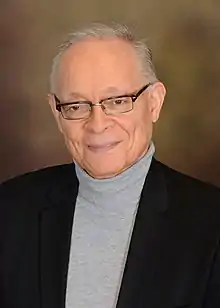Jorge V. José
Jorge V. José is a Mexican/American physicist born in Mexico City. Currently the James H. Rudy Distinguished Professor of Physics at Indiana University. He has made seminal contributions to research in a variety of disciplines, including condensed matter physics, nonlinear dynamics, quantum chaos, biological physics, computational neuroscience and lately precision psychiatry. His pioneering work on the two-dimensional x-y model has been exceedingly influential in many areas of physics and has garnered many citations.[1] He edited the book on the “40 Years of Berezinskii-Kosterlitz-Thouless Theory”, on two-dimensional topological phase transitions in 2013.[2][3] Three years later KT were awarded the 2016 Nobel Physics Prize.
Jorge V. José | |
|---|---|
 | |
| Born | Jorge José-Valenzuela |
| Alma mater | National Autonomous University of Mexico (B.Sc 1971) National Autonomous University of Mexico (Doctor of Science 1976) |
| Scientific career | |
| Fields | Theoretical physics, Computational neuroscience and Psychiatry |
| Institutions | National Autonomous University of Mexico (UNAM) Brown University University of Chicago Rutgers University Northeastern University Institut Laue–Langevin University at Buffalo, SUNY Indiana University |
| Doctoral advisor | Leo P. Kadanoff |
Life and career
José was born in Mexico City. He studied physics at the National University of Mexico. He finished his undergraduate degree in two and a half years, including an undergraduate thesis. He did his Ph.D. thesis under the advice of Leo P. Kadanoff at Brown University within a couple of years. Kadanoff hired him as a postdoctoral fellow thereafter during which time they wrote the ‘JKKN’ paper together with Scott Kirkpatrick and David Nelson.[1] The paper provided a theoretical foundation and extensions of the Berezinskii-Kosterlitz-Thouless (BKT) theory.[2][3]
After Brown University he was at the University of Chicago (1977-1979) as the first James Frank fellow. At Rutgers University he was a Research Assistant Professor for a year in the group of Elihu Abrahams. He joined the Northeastern University faculty where he was promoted from Assistant (1980-84), Associate (1984-88) to Full professor (1988-1994). He was then the Mathews University Distinguished Professor (1996-2007). In 1995 he was the founder and director of the ‘Center for Interdisciplinary Research on Complex System’ (CIRCS) at Northeastern (1995-2015). From 2005-2010 he was the Vice President for Research of the ‘System University of New York’ at Buffalo and a professor of Physics and Biophysics. From 2010-2016 he was the System Vice President for Research of Indiana University, being a member of the Physics Department in Bloomington and of the Stark Neuroscience Institute plus Adjunct Professor of Cellular & Integrative Physiology, at Indiana University School of Medicine,in Indianapolis.
He has been a visiting Professor at: The Laue-Langevin Institute, Grenoble, France (1984-1985): The Saclay Nuclear Research Centre, Paris, (1985): The Center for Theoretical Physics, University of Utrecht, the Netherlands (1994-1995): The Salk Institute for Biological Sciences (2001, 2016).
Scientific contributions
Apart from the JKKN paper José has published over 225 papers on: 1) Phase Transitions and Critical Phenomena. 2) Quantum and Classical Josephson Junction Arrays: 3) Superconducting Gauge Spin Glasses: 4) Localization in Lower Dimensional Systems: 5) Quantum and Classical Chaos: 6) Nonlinear Dynamics, 7) Solitons: 7) Cell biology models of the formation of the mitotic spindle: 8) Computational Neuroscience: 9) Neurodevelopment Disorders (his recent paper [4]) was ranked top 100 out of out of 1627 papers published in neuroscience in Scientific Reports (Nature): 10) Precision Psychiatry (see CV for references or short neuroscience bio).
Books
In Collaboration with E. Saletan he published a graduate textbook on “Classical Mechanics: A contemporary approach”.[5] The book has been used extensively in graduate programs in the US and around the World.” He edited the book on the “40 Years of Berezinskii-Kosterlitz-Thouless Theory”, in 2013.[6] As a celebration of the 2016 Nobel Physics Prize he co-organized a meeting in Singapore together with Prof. L. Brink, Prof. J. M. Kosterlitz , Prof. M. Gunn and Prof. K. K. Phua. The proceedings of the meeting were published by World Scientific.[7]
Honors and awards
- James Franck Fellow, James Franck Institute, University of Chicago (1977–1979)
- Fellow, American Physical Society (1997)
- Corresponding Member, Mexican Academy of Sciences (2000-)
- Chercheur Etranger D’Haut Niveau et de Renommée Internationale, From the French Government (2002)
- Fellow American Association for the Advancement of Science (AAAS) (2007-)
- Indiana University Bicentennial Medal (2020).
- Thomas Hart Benton Mural Medallion, Indiana University (2015).
- Member of the Alliance of Distinguished and Titled Professors, IU (2010-)
- Chinese Academy of Sciences President’s International Fellowship Initiative Awards, (Beijing, 2016, 2018)
References
- Berezinskii, VL (1972). "Destruction of long-range order in one-dimensional and two-dimensional systems possessing a continuous symmetry group. II. Quantum systems". Sov. Phys. JETP. 34 (3): 610–616. Bibcode:1972JETP...34..610B.
- Kosterlitz, John Michael; Thouless, David James (1973). "Ordering, metastability and phase transitions in two-dimensional systems". Journal of Physics C: Solid State Physics. 6 (7): 1181. Bibcode:1973JPhC....6.1181K. doi:10.1088/0022-3719/6/7/010.
- José, Jorge V.; Kadanoff, Leo P.; Kirkpatrick, Scott; Nelson, David R. (1977). "Renormalization, vortices, and symmetry-breaking perturbations in the two-dimensional planar model". Physical Review B. 16 (3): 1217. Bibcode:1977PhRvB..16.1217J. doi:10.1103/PhysRevB.16.1217.
- Wu, Di; José, Jorge J.; Nurnberger, John I.; Torres, and Elizabeth B. (2018). ""A Biomarker Characterizing Neurodevelopment with application in Autism". Scientific Reports. 8 (1): 614. Bibcode:2018NatSR...8..614W. doi:10.1038/s41598-017-18902-w. PMC 5766517. PMID 29330487.
- José, Jorge V.; Saletan, Eugene J. (August 13, 1998). Classical Mechanics: A Contemporary Approach. Cambridge, UK: Cambridge University Press. p. 698. ISBN 0521636361.
- José, Jorge V., ed. (June 18, 2013). 40 Years of Berezinskii-Kosterlitz-Thouless Theory. World Scientific. p. 364. ISBN 978-9814417631.
- José, Jorge V. (August 13, 2018). Brink, Lars; Gunn, Mike; José, Jorge V.; Kosterlitz, John M.; Phua, K. K. (eds.). Topological Phase Transitions and New Developments Conference Proceedings. World Scientific. p. 398. ISBN 978-9813271333.